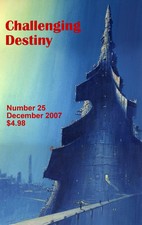


Challenging Destiny Home
What's New
Read a Copy
Issues
Stories
Reviews
Interviews
Editorials
Review of Challenging Destiny
Number 16, June 2003
This review is by Andrew Belsey, from New Hope International Review.
I do not respond as favourably as some previous reviewers to this publication, but then, it's just not my kind of thing. And it's not only the stories that don't appeal to me. This issue opens with an editorial by David M. Switzer.
If this is the Information Age then we should all be very well informed.But, it continues, clearly we are not if we rely on mainstream television, newspapers and magazines. Although this is true, it is hardly a startling revelation. And then there are the Reader's-Digest-type page-fills, boxes containing profundities like
When you defeat a thousand opponents, you still have a thousand opponents. When you change a thousand minds, you have a thousand allies.Is any method allowed? Even brain-washing? We are not told. And suppose you've killed as well as defeated all your opponents? There is a difference between philosophy and fortune-cookies.
Turning to the stories themselves, the general form seems to be to expand time (so the setting is always in the future) and space (so the action is cosmic, not earth-bound). It follows from the space travel that technology has advanced a long way. It is perhaps possible to differentiate the science fiction, in which something like the present world is projected into a high-tech future, from the science fantasy, in which an imaginary medieval/Celtic world containing people with names like Hirs'taelyn is projected into a high-tech future.
In the stories the issues are not quite so clear-cut, of course. GENERAL DENSITY by Uncle River is about the search for a product that will counter the effects of low gravity. The answer seems to be to live without a body. (Descartes's dream, perhaps?)
In PART OF THE NEW MASTER PLAN ... by Vincent W. Sakowski authors who are popular but have nothing worth saying are assassinated by the state. (Irony?)
ETAMIN AT EAST 47th by A.R. Morlan concerns a man from Japan who shares a YMCA bathroom with a creature from space, each trying not to tread on the other's toes and taboos. (Two aliens in New York, geddit?)
In THE EAR OF MT. HORIUCHI by Ken Rand a reporter tries to discover from the horse's mouth the suppressed truth about a military incident on a rebel planet. (Taking up the editor's theme: the difference between what we are allowed to know and what actually happened.)
SOOTHE THE SAVAGE BEAST by Michael R. Martin is about two musicians, male and female, who live in a future medieval society and create visual images as well as sounds with their instruments, compete to see who is best, and have sex. (The eternal battle of the sexes.)
All these stories are dystopian, in that they show us societies that no one sensible would want to live in. I wonder why?
In this issue there is also an interview with author Alison Baird and reviews of classic books on time travel. The magazine is well produced, with a colour cover and plenty of black-and-while illustrations of dungeons, dragons and maidens in tightly laced corsets. Not even the latter could arouse my enthusiasm. But that's just me. If this is the sort of thing you like, then you'll like this.
Last modified: February 25, 2005
Copyright © 2003 by New Hope International Review